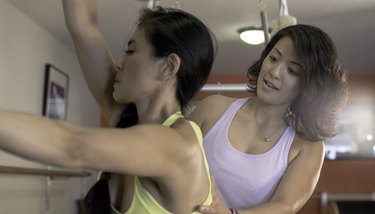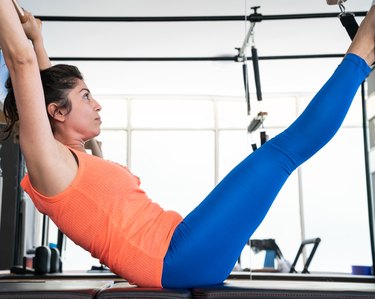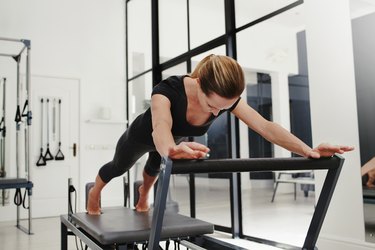
Although it may be new to you, Pilates is decades old. Former athlete Joseph Pilates created the system of exercise to help rehabilitate his peers in an internment camp during World War I. These days, it's still taught as Pilates created it — albeit in much nicer surroundings — though there are many contemporary styles that stray from the classical system.
For a beginner, Pilates can be a bit confusing. There are "mat" classes, and there's something called the "reformer." There are also other types of equipment, such as the the Tower and the Cadillac, although mat and reformer Pilates are the most common methods taught in studios. Two distinct modalities, each with their own benefits. Which one is better — and which one should you try?
Video of the Day
Video of the Day
But First, the Basics
Pilates is a complete system of exercises designed to build strength and muscle tone, enhance balance and mobility and bring the body into harmony. Although the variety of exercises in the Pilates system target all the major muscle groups, they are designed to particularly work the body's core — or "powerhouse" in Pilates lingo.
Including the superficial and deep muscles of the abdomen, lower back and hips, the core connects and stabilizes the upper and lower body and promotes optimal functioning of the two halves together.
Mat Pilates consists of body-weight exercises such as the Hundred, swan-dive, teaser, single-leg circle, roll-up, seal, crab, and roll-over. They are performed low to the ground and involve smooth, fluid movements that are easy on the joints, making them suitable for almost anyone of any age or health status.
Reformer exercises are those performed on a contraption that uses springs, gears, straps and ropes to provide resistance. Many of the exercises on the reformer are the same as mat exercises, but performed against this added resistance.
Another major part of Pilates — in both mat work and reformer exercises — is the specialized breathing technique, which involves expanding the rib cage in all directions during inhalation, and compressing the rib cage and gently pulling up on the pelvic floor during exhalation.
Inhales and exhales are coordinated with movement to prevent holding the breath. The breath also influences the mind-body nature of Pilates.
Read more: The 41 Hardest Ab Exercises

Classical vs. Contemporary Pilates
The other need-to-know info when you're new to Pilates is the distinction between classical and contemporary. Classical Pilates follows the original system as Pilates created it, and the traditional exercises are performed in his original order.
Contemporary Pilates is based on the classical system, but it has been influenced and altered by scientific research, physical therapy and biomechanics. Many exercises are the same as the classical system, but new exercises have been added and traditional exercises have been modified.
Both classical and contemporary Pilates may include equal amounts of mat and reformer exercises, so your experience will depend on the type of class you choose.
"Classical is great for someone who wants to work in the foundations, loves structure and repetition," says Robyn Martin, founder and owner of Proof Pilates in Atlanta, GA. "However, a beginner can often feel slightly intimidated going into a class of regulars who seem to know all the choreography."
On the other hand, Martin says, contemporary Pilates will often include new moves that no one in the class has tried before, which can make it a little less daunting when other experienced practitioners are also learning something new. Ultimately, it shouldn't make much of a difference. "Mostly it depends on if you have an informed and positive teacher who knows how to modify and challenge safely," Martin says.
Read more: Does Pilates Help You Lose Weight?

Better for Beginners
You can expect anything you do for the first time to be challenging, awkward and even a tad embarrassing. "I always tell people that everyone feels awkward in Pilates. Similar to learning to rock climb, in the beginning everyone is in the same boat. It's meant to be humbling," says Martin.
If you plan to try mat Pilates, you can take the easier path by watching an online video to learn some exercises you can do at home before going to a class. (You can't do that with the reformer — unless you own the expensive equipment.)
Besides the easy access of mat Pilates exercises compared to the reformer, Martin doesn't think one is necessarily better than the other for beginners. "Mat pilates seems to be less intimidating because the equipment can look scary.
Mat often looks like exercises we have seen before in aerobics classes or home videos like Jane Fonda — my personal hero," says Martin. "However, equipment/reformer classes can really help a beginner to find their alignment and feel supported in positions that might be difficult to hold when relying on their own body weight."
The only time Martin says that one form of Pilates is definitely better than the other is if a person has physical limitations. In these cases, the reformer can better help support and stabilize a person with compromised mobility — which potentially provides a better outcome and may help him or her avoid injury, or re-injury.
"The spring system on equipment adds resistance, which can add a challenge but can also add support and allow for more tangible modifications," she says.
Read more: Best Beginner Workout Routines for Women
Pilates for Different Goals
Once you've learned the basic moves and begin to feel more comfortable, you can decide which modality will help you reach your goals — and that may include doing both. For instance, if your goal is weight loss, you'll want to both burn calories and build muscle. For that, the reformer might have an edge on mat classes, says Martin.
"I would lean towards reformer for weight loss. I think instructors tend to push the intensity more, and you have resistance that you can add. Plus, the reformer has a jump board, so you can get some cardio in with plyometric work," she says.
Because of the resistance, the reformer is also a better choice for those looking to build muscle and strength. Although you're not going to become the Incredible Hulk on a reformer, the ability to work against more than your body weight does provide the added stimulus necessary for continued growth in mass and strength.

Doing Both Is Best
Pilates is about balance, and the system was designed to include both mat and reformer practices. "They were created to complement each other," says Martin. "Almost all exercises found on the reformer can be found on the mat. You may not be able to execute a teaser — a classical gold standard in Pilates — on the reformer right away, but practicing on the mat will build strength and confidence for you to reach that goal on the equipment."
How often you practice Pilates each week depends on your schedule and budget. Going at least twice a week in the beginning is ideal. This can help you learn the language, become more comfortable on the equipment and build confidence.
After that, Martin recommends three or more sessions — both mat and reformer — each week as your schedule and finances allow. "Twice a week, you will see results quicker — and it will stay in your body longer," she says. "Three times a week, and it will become a lifestyle."
Read more: 10 Surprising Benefits of Pilates
- Robyn Martin; Pilates Teacher; Atlanta, GA
- WebMD: Pilates for Beginners
- Balanced Body: Pilates Origins
- Love for Pilates: Pilates Powerhouse – what does it mean?
- BASI Pilates: The Classical Pilates Mat Exercises Listed
- Merrithew: The Basic Principles: Breathing
- New York Pilates: Classical vs. Contemporary